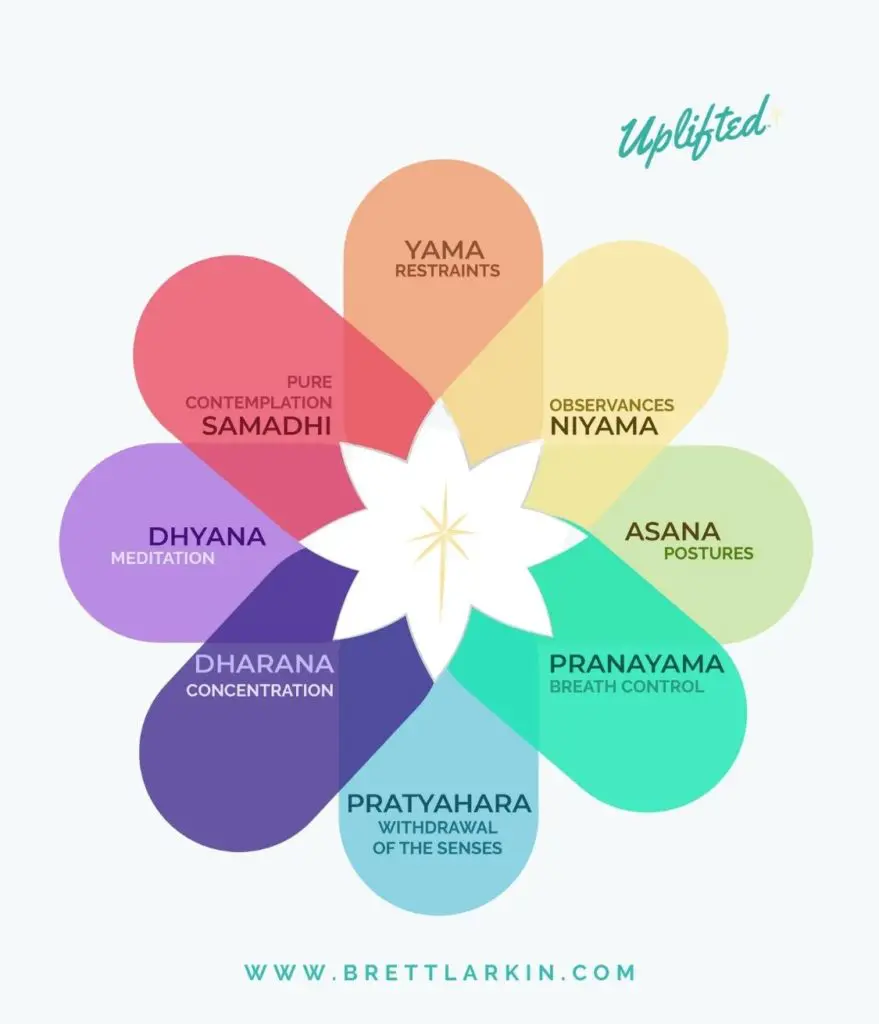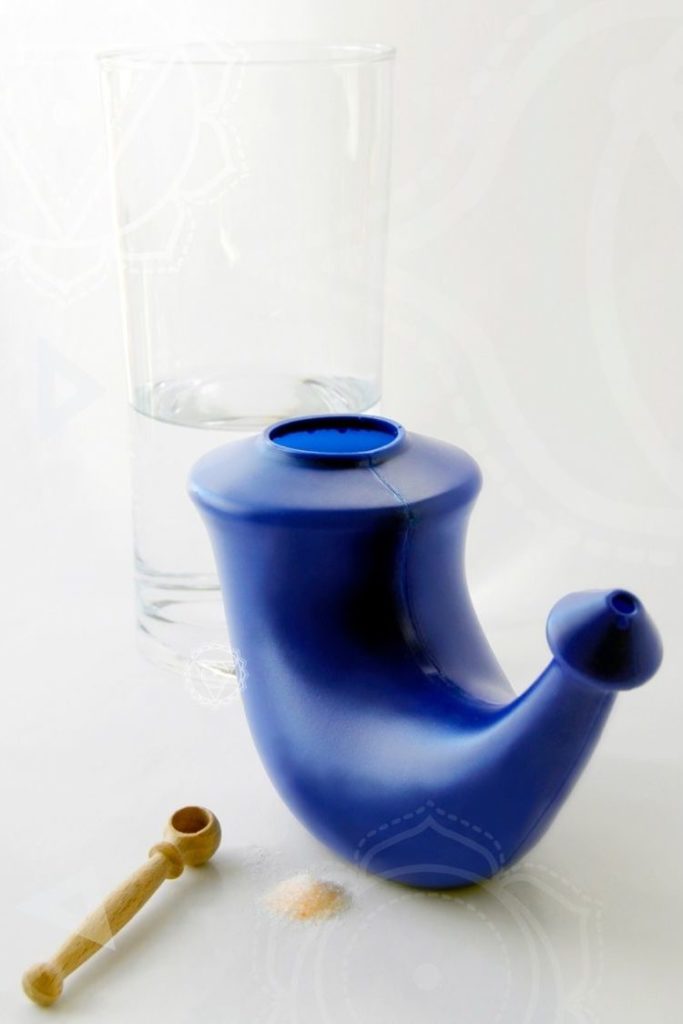What’s better than fad diets and weight loss drugs? Cultivating a sustainable, well-rounded, healthy approach to your lifestyle.
The ancient yogis knew this. In fact, they created a series of techniques aimed to cleanse the body of toxins and impurities to enhance both energy and mental clarity. These practices are called the Shat Kriyas.
What Are Shat Kriyas In Yoga?
The Shat Kriyas, also known as the Shat Karmas, provide us with a comprehensive body detox. “Shat” translates to “six,” “Karma” to “action,” and “Kriya” to “completed action.” Outlined in the foundational text of Hatha Yoga Pradipika, these six yogic cleansing practices are designed to purify the body, facilitating an optimal flow and balance of prana (life force energy).
So why do a yogic cleanse? This entire concept is a beautiful nod to “saucha,” the very first Niyama in the eight limbs of yoga, which is all about purifying our physical vessel, ensuring the energy within us, our prana, flows freely and harmoniously.
And here’s where it gets really interesting: Saucha isn’t just about scrubbing away physical dirt; it’s a call to cleanse our inner world, to prepare ourselves for the transformative power of yoga.
When I weave the Shat Kriyas into my routine, it’s a ritual, a sacred time I dedicate to not just my body’s health, but to setting the stage for deeper, more profound yoga practice. It’s about honoring the principle of cleanliness, making space for new energy, and preparing my mind for the journey towards meditation and, ultimately, enlightenment.
What Are The Benefits Of Yogic Kriyas?
The Shat Kriya cleansing techniques are structured to awaken and create harmony between the two major pranic flows in your body, ida and pingala nadis. This is in order to promote increased vital energy and physical and mental health.
Also, the shat kriyas help to balance the three Ayurvedic doshas: Kapha (mucus), Pitta (bile) and Vata (wind). Why would you want to create this symmetry? According to Ayurveda and Hatha yoga, imbalance in the body results in illness. Balance in these energies equals optimal health in your human body and easier ability to progress spiritually.
Are You Chanting Correctly? Refine Your Tune with Me! 👇

Are You Chanting Correctly? Refine Your Tune with Me!

How To Practice The 6 Shat Kriyas
The six cleansing techniques outlined in the Shat Kriyas are:
- Neti (Nasal Cleansing)
- Kapalabhati (Sinus Cleansing)
- Nauli (Abdominal Massaging)
- Dhauti (Internal Cleansing)
- Basti (Yogic Enema)
- Tratak (Concentrated Gazing)
Now, let’s continue our yoga journey and dig into each of these six parts of the ancient yoga complete guide to health.
1. Neti – Nasal Cleansing
Neti practices cleanse your nasal passages. There are two Neti practices: Jal Neti (also known as Jala Neti) and Sutra Neti.
Benefits of Neti include:
- Cleans your nasal passages by flushing out excess mucus and foreign bodies
- Enables optimal breathing for increased vitality
- Relieves sinus headaches
- Enhances concentration
- Promotes relaxation (due to focus on flow of water and relaxed breathing)
- Awakens the Third Eye (Ajna) chakra
How to practice:
Jal Neti
Jal Neti is performed with a Neti Pot and lukewarm saline water. It’s commonly recommended to use clean, boiled water that has cooled, rather than take water straight from the tap.
It’s also recommended to be performed in the morning or any time before asanas and pranayamas to allow for optimal air flow.
Bonus: Jal Neti can be exceptionally beneficial during allergy season or if you’re suffering from a sinus infection.
Sutra Neti
Sutra Neti is performed with thread dipped in beeswax which is passed through the nasal passage. This practice is complex and best done under guidance of a yoga professional to ensure you perform it safely.
2. Kapalbhati – Sinus Cleansing
Kapalbhati are three practices to cleanse the sinuses. The Kapalbhati practices that incorporate water should not be practiced until competent with Jal Neti.
The three practices are:
- Vatkrama Kapalabhati (air cleansing): Today this is the most well-known of the three techniques. It is commonly referred to as Kapalbhati Pranayama, Kapalabhati, Breath of Fire or Skull Shining Breath.
- Vyutkrama Kapalabhati (sinus cleansing)
- Sheetkrama Kapalbhati (mucus cleansing)
Benefits of Kapalbhati include:
- Kapalbhati Pranayama is good for the respiratory system and has a cleansing effect on the lungs. It also massages the digestive organs and energizes the mind.
- Vyutkrama and Sheetkrama remove mucus from sinuses and share similar benefits with Jal Neti.
How to practice:
Vatkrama Kapalbhati (air cleansing): This involves forceful exhalation followed by natural inhalation, primarily focusing on cleansing the respiratory system and energizing the body.
Vyutkrama Kapalbhati (sinus cleansing): Lean forward over a bowl of lukewarm salty water, scoop water with hands, sniff it through the nostrils and expel it from the mouth.
Sheetkrama Kapalbhati (mucus cleansing): Lean forward over a bowl of lukewarm salty water, scoop water with hands, intake water through mouth and expel it from the nose.
3. Nauli – Abdominal Massaging
Nauli Kriya teaches you how to do a hands free massage of your abdominal organs using suction that you create in your body.
Benefits of Nauli Kriya include:
- Massages the major organs in your abdomen and the digestive tract
- Stimulates nerves and glands of the Solar Plexus region (Manipura Chakra)
- Strengthens your abdominal muscles
How to practice:
Nauli is a multi-step progression:
- Begin with Uddiyana Bandha, also known as the Abdominal Lock.
- Progress to Agnisara Kriya.
- Continue to Madhyama (Middle) Nauli.
- Advance to Vama (Left) and Dakshina (Right) Nauli.
- Culminate in Nauli Kriya, which is a combination of all the previous steps.
4. Dhauti – Internal Cleansing
Dhauti kriya is another multi-step kriya. Unlike Nauli, the steps do not need to be performed in a particular order. Each Dhauti practice is meant to cleanse the internal organs of the digestive system in order for it to function optimally.
There are four categories of Dhauti which each contain multiple practices:
- Danta (Focus on teeth, mouth, and head)
- Antar (Focus on abdominal organs)
- Hrid (Focus on upper respiratory digestive tract and thoracic region)
- Moola Shodhana (Focus on the excretory region, anus and rectum)
Because your digestive function plays such a pivotal role in your well being and mental health, there are many proposed benefits to Dhauti Kriya.
Benefits of Dhauti include:
- Enhances prana flow
- Increases bodily awareness
- Promotes mental clarity
- Deepens yoga practice
- Promotes emotional stability
How to practice:
- Danta Dhauti: Cleanse the mouth, teeth, and tongue through brushing, scraping, and rinsing with water.
- Antar Dhauti: Purify the abdominal organs by drinking warm salt water and performing specific yoga poses to facilitate internal cleansing.
- Hrid Dhauti: Cleanse the upper digestive tract and thoracic region by swallowing a cloth soaked in warm water, then gently removing it.
- Moola Shodhana: Gently cleanse the anal and rectal areas using a soft, wet cloth or fingertips to promote hygiene and remove impurities.
Note that as modern yoga practitioners, some of these practices are no longer recommended and those to be cautious of are noted in the post.
5. Basti – Yogic Enema
Basti kriya, also called Vasti, are three techniques aimed to cleanse your colon, the longest part of your large intestine. Basti helps to move debris through and out of the body.
The three Basti Kriya practices are:
- Jala Basti Kriya
- Sthal Basti Kriya
- Moola Shodhana
Benefits of Basti include:
- Improves digestive health
- Reduces abdominal disorders
- Improves cognitive health
How to practice:
- Jala Basti Kriya (Yogic Enema with Water): This involves introducing lukewarm, saline water into the colon through the rectum to cleanse the lower digestive tract.
- Sthal Basti Kriya (Dry Yogic Enema): A technique that uses air instead of water, employing specific breathing and abdominal contractions to stimulate the cleansing of the colon.
- Moola Shodhana (Anal Cleansing): A gentle cleansing method that involves the use of a soft, wet cloth or fingers to cleanse the anal area, promoting hygiene and removing impurities.
Due to the internal nature of these practices, it’s crucial to consult your doctor before attempting them to ensure they are safe for you. These practices are internal body work and it is recommended that you consult your doctor prior to performing them to make sure it is safe for you to do so. It is also advised that these practices be performed under the guidance of a competent yoga therapist/teacher or Ayurvedic practitioner.
6. Tratak – Concentrated Gazing
The Tratak practice is the last of the Shat Kriyas. It is the bridge between the physically oriented practices into the mental.
Tratak, also referred to as Trataka, is a practice in which you concentrate your gaze, or drishti, on a single candle flame to focus the mind. It’s believed that once you are able to channel all of your concentration to this point, latent potential within the mind can arise spontaneously.
It’s a great method to clear mental chatter and complexes that may have developed or been suppressed. Please take care in processing these as they surface. Journaling may help. If you feel overwhelmed, stop. It can be helpful to seek guidance from a competent yoga teacher to continue with your Tratak practice.
If you are epileptic or have any eye conditions like eyestrain, astigmatism or cataracts, a black dot should be used as a focal point instead of candle gazing. If practicing with a black dot, make sure you have good lighting, daylight hours may be best. If you have trouble with the black dot, especially if you are epileptic, any steady object can be used to focus your gaze.
If you have glaucoma it is recommended that you not practice Tratak.
Benefits of Tratak Include:
- Clear and bright eyes
- Balances the nervous system, relieves stress and tension
- Improves memory
- Develops good concentration
- Develops strong willpower
- Activates Third Eye (Ajna) chakra
How to practice:
Tratak utilizes a lit candle. Ensure that you are practicing in a safe environment and that there is no breeze or draft.
Set up a comfortable space to sit and light a candle. Try to have the flame at eye level when you are sitting. Adjust the position of the candle so that it is about an arms length away from you.
Let’s begin!
- Sit in a comfortable meditation position with spine tall and head aligned over your shoulders.
- Close your eyes. Relax your eyes and body.
- Open your eyes and gaze at the flame. Try not to move your eyeballs or blink. Be gentle with yourself, you want to avoid unnecessary strain or tension on your eyes. Keep a soft gaze and blink if you need to. You’ll increase the time your eyes can remain open gradually with continued practice.
- Keep your awareness completely centered on the flame. Your body awareness will begin to dissipate. If your mind begins to wander, notice this without judgment and softly bring your focus back to the flame.
- When your eyes become tired or begin to water, close them gently.
- Gaze at the shadow image of the flame on your closed eyelids. Once the shadow image fades, open your eyes and gaze at the flame again.
- This will begin another round of gazing until your eyes tire or water and then closing your eyes. Try to do 3 or 4 rounds.
- After you finish your final round, keep your eyes closed, raise your hands, and place your palms gently over your eyes for about 15 to 30 seconds.
- Lower your hands to your lap and open your eyes.
As a beginner with this practice, aim for 1 to 2 minutes of gazing, then close your eyes. With multiple rounds, 5 to 10 minutes of practice is a great range to work with.
If you have insomnia or are stressed, this practice for 10 to 15 minutes before bed can be helpful as a sleep aid. Just make sure you extinguish your candle before you go to bed!
Since you will be sitting in stillness for this practice, it can be helpful to get some energy out first. My suggestion? Try to move through some asana to ground yourself.
Take my quiz to learn if YOUR kundalini energy is awakened 👇
Yogic Cleansing and Your Yoga Journey
Do you have to perform the Shat Kriyas to have an enriching and optimal yoga practice? Absolutely not. In fact, I don’t recommend some of these practices based on modern knowledge.
My hope is that knowing more about the history of these practices and the focus that ancient yogis put on maintaining good health are inspirational to you. Today, maybe your optimal health comes from eating for your dosha or taking stock of your diet and making adjustments to better your mood and energy. You can learn more about Prana, the life-force energy within you, in Uplifted.
Curious about how to incorporate the teachings of Ayurveda into your daily life? Join me in my 200 HR Yoga Teacher Training where I go more in depth.
Next Steps
- Take a deep dive into embodiment and somatic yoga with my Somatic Yoga certification program.
- If you’re interested in practical kriya yoga as a way to improve your daily life and relationships, check out my Yoga for Self Mastery course.
Get 3 Free Training Vidoes from our Kundalini University Experience & Certification Program

YOU MIGHT ALSO LIKE
- Ong Namo Guru Dev Namo: The Adi Mantra Explained [VIDEO]
- Kirtan Kriya: Kundalini Meditation That Will Make You Feel Better
- Sat Nam in Kundalini Yoga: Sanskrit Translation and Meaning
- Sat Kriya: A Yoga Practice You Can Do in 3 Minutes
- Shuni Mudra: The Seal of Patience
- Buddhi Mudra: What Is It And How Do You Use It?
- Adi Shakti Mantra: Manifest Your Divine Femininity
- Venus Mudra: The Seal of Clarity & Empowerment
- Why the Aquarian Sadhana Is The Ultimate Morning Yoga Practice
- The 7 Aquarian Mantras: Tune In To Profound Transformation
- What is Japji? The Sacred Ritual, Explained
- Chanting Mantras: Unlock the Secrets of These Spiritual Formulas
- 8 Kundalini mudras for health and energy
- How to Chant the Mangala Charan Mantra (With Pronunciation)
- The Kundalini Kriya For Elevation, Step-By-Step














